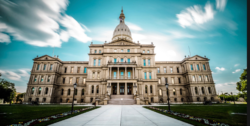


Michigan’s State Capitol Building is an impressive structure situated in the mid-state city of Lansing. It has served as Michigan’s state house since its dedication in 1879, and is the third building to have served as Michigan’s Capitol. The first was a Greek revival styled territorial courthouse located in Detroit. The Capitol was moved to Lansing in 1847 – a temporary wood structure that was found to be inadequate, so a larger, fireproof structure was proposed. The current Capitol building was designed by Illinois architect Elijah E. Myers, who modeled it after the United States Capitol in Washington DC, in a similar neo-classical style. Mr. Myers’ design was selected from among 20 entries in a nationwide competition, and was considered to be the only one which could be constructed within the named budget of $1.2 million. Myers went on to design several more state Capitols, establishing the neo-classical style and fire-proof construction as an American standard for statehouses.

The Michigan State Capitol has a cruciform plan with a central dome flanked by symmetrical wings on either side, housing the two chambers of state government. The four-story exterior features a central monumental stair and classical pedimented front. The facade of the brick structure is faced with Ohio sandstone. Many of the building’s materials came from outside of Michigan, with material choices made based on budget rather than origin, most notably the black and white checkerboard floor tiles which are made of Vermont marble and limestone. The central rotunda located below the dome features a 44 1/2-foot diameter luminous floor of 976 translucent glass tiles in an iron frame. The glass floor creates an optical illusion when viewed from above, giving the floor a bowl-like appearance, mirroring the dome above. The iron-framed dome, one of the building’s most striking features, rises 160 feet to the opening of the oculus.
On the exterior, the outer dome and lantern rises 100 feet higher still, to 267 feet. The Michigan State Capitol features extensive decorative painting from the Victorian era and stands as one of the best surviving displays of the craft in the United States. The interior of the rotunda and dome are elaborately painted, including depictions of eight muses painted on panels ringing the dome. The goddesses represent art, agriculture, law, science, justice, industry, trade, and education. Decorative painting is utilized throughout the Capitol to give the appearance of opulence, even on inexpensive materials. Pine wainscots and trim throughout the building are hand-glazed using a technique called “graining”, giving the woodwork the appearance of fine walnut. Cast iron columns and plaster pilasters are painted to look as though they are marble, and sculptural wall reliefs and flourishes are painted on. Other details include the Michigan coat of arms cast into the door hinges and doorknobs and the “Michigan Chandeliers”, featuring the Michigan elk and shield with the state motto “Tuebor”.
Extensive interior and exterior restoration projects have returned the Capitol to its original splendor. The Michigan State Capitol was named a National Historic Landmark in 1992. Guided and self-guided tours are available Monday through Friday from 9am- 4pm and are free of change. http://capitol.michigan.gov/